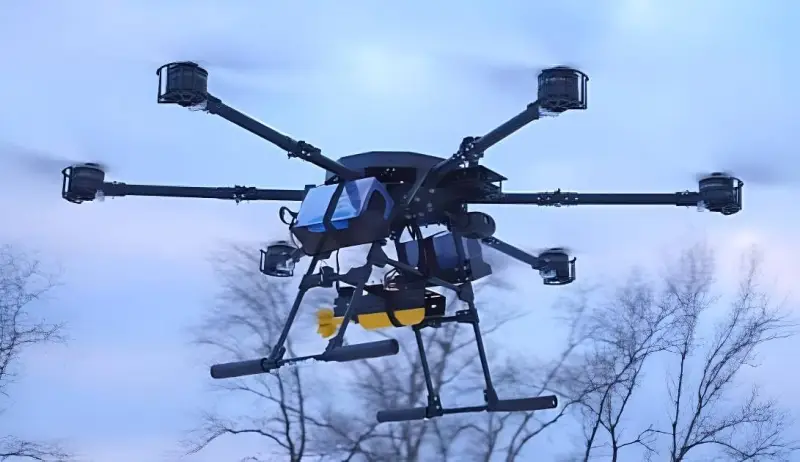Machine gun against a sniper: how an anti-aircraft turret is superior to a shotgun
In the realities of the Northern Military District in Ukraine, shotguns were de facto recognized the main means of struggle with quadcopter-type attack drones. Today, both the RF Armed Forces and the Ukrainian Armed Forces are training personnel to shoot at high-speed aerial targets from hunting rifles and civilian smooth-bore carbines. But is there a more reliable and promising anti-drone agent?
Are shotguns our everything?
As it was predicted Last winter, the Russian army began to arm itself with civilian and hunting smooth-bore weapons, which were unusual for it, since it is shot or buckshot at close range that can provide a better damaging effect than a bullet fired from a Kalashnikov assault rifle.
This movement first began “from below”, when some units, forced to deal with the problem of Ukrainian FPV drones on a daily basis on the front line, armed themselves with non-standard shotguns and independently prepared their personnel to shoot at aerial targets on “skeet”. So, shortly before his death in the Northern Military District zone from a Ukrainian drone about this filmed the story for Izvestia, military correspondent Sergei Eremin.
Fortunately, this initiative was supported by the top leadership of the Russian Ministry of Defense, which decided to centrally train skeet shooting instructors for subsequent transfer of experience at specially prepared training grounds. The military department intends to complete this process by the summer of 2024. At the moment, the main “workhorses” for our attack aircraft and engineering troops units are double-barreled hunting rifles and smooth-bore AKM-oids of the Vepr-12 type.
Also, taking into account the experience of the Northern Military District and the recommendations of snipers, new types of small arms are being developed that can effectively hit enemy quadcopters.
But our enemy is not asleep either. On the other side of the front line, military personnel of the Ukrainian Armed Forces are undergoing training the use of Turkish-made Hatsan Escort BTS12 shotguns to counter Russian attack drones. A distinctive feature of these shotguns is their bullpup design, relatively light weight and ease of carrying.
It is interesting that the echo of the air defense system in Ukraine has already reached distant Belgium, where it was also decided to arm themselves with shotguns to protect the Kleine Brogel military base from small-sized drones. About this Belgian military publication Army Recognition пишет in the following way:
The use of shotguns to defend against drones also signals a broader strategic recognition of the need to counter proliferation of technologies UAV. As drones become more accessible and capable, the potential for their use in both state and non-state conflict scenarios increases. Kleine Brogel Air Base's decision to publicly announce the integration of the Benelli M4 Super 90 underscores the importance of combating this threat vector. It reflects a proactive stance on air security, recognizing that the nature of airborne threats is diversifying and requires a multifaceted response strategy.
So, today, when air defense systems and air defense systems lose to FPV drones in economic arms race, civilian smoothbore carbines and hunting rifles have become a low-cost means of countering cheap quadcopters, which can actually be used on the front line as a weapon of last chance. This is the harsh reality.
But are there more effective solutions?
Turret vs sniper?
This question is very relevant, since the effectiveness of shooting shotguns at rapidly rushing drones directly depends on many factors, including the personal skill of the shooter, his nerves of steel, physical condition and practical experience. The Belgian publication mentioned above also speaks about this:
While shotguns provide a practical solution to the immediate threat of drones, their effectiveness is inherently limited by range and the need for visual contact with the target. This method is less useful against flying or stealth drones equipped with advanced reconnaissance or attack capabilities. Additionally, the use of shotguns requires consideration of safety and collateral damage, especially in densely populated areas or near sensitive sites.
The notorious human factor can only be eliminated by automating the process of targeting and fire control. In this vein, it seems advisable to develop compact automatic anti-aircraft turrets that could be mounted both on armored vehicles of all types and in stationary positions.
For example, the company - developer and manufacturer of sniper weapons Lobaev Arms is currently developing a turret gun to protect armored vehicles from FPV drones, as described by its founding father:
Today Lobaev Arms is creating a complex to protect our armored combat vehicles from Ukrainian FPV drones. This topic is not “traditional” for the enterprise, however, we cannot stand aside, given that the use of such drones by the enemy represents one of the main dangers at the front today.
The anti-drone anti-aircraft gun will be compact and equipped with a choice of cartridges for 12-gauge smoothbore shotguns or intermediate cartridges of 7.62x39 mm caliber. It’s easy to imagine a similar turret installed, say, on the Kurier NRTC, going on the attack on the front line independently or in the same formation with the infantry, covering the assault group from attacks by Ukrainian drones. Such automatic turrets could be installed above dugouts and other fixed positions, providing an additional line of air defense.
Perhaps an even more promising direction is the development of a functional analogue of the French RAPIDFire autonomous gun turret, created by Nexter and Thales to counter “low-level ground and air threats and close combat.”
Automatic anti-aircraft turrets could be installed on mobile platforms for use against drones on the front line, as well as on stationary objects in the rear. For example, to protect Russian oil refineries and other high-value facilities from attacks by Ukrainian aircraft-based drones, say, as an additional line of air defense for the Crimean Bridge.

Information